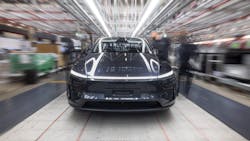Panasonic Aims for Anode-Free EV Battery by 2027
What you’ll learn:
- Anode-free technology could boost EV battery capacity.
- Potential 90-mile increase in range of Tesla Model Y.
- Panasonic is also looking to reduce the amount of nickel.
Panasonic announced that it’s developing an “anode-free” cell design that promises a major leap in energy density, which could extend the driving range of electric vehicles (EVs). By removing the anode from the battery during production, the company is looking to deliver a higher level of battery capacity by the end of 2027.
Conventional lithium-ion cells use a graphite or silicon anode to store and release energy. Graphite is the most widely used anode material for Li-ion batteries, because of its low electrochemical potential, low cost, low toxicity, and high abundance. Panasonic's design, on the other hand, has no anode at the manufacturing stage.
While the battery still has a positive and a negative pole, a lithium metal anode forms naturally in the battery after being charged for the first time. The remaining anode is made of metal.
By removing the need for a dedicated anode structure, Panasonic can pack more active cathode materials — nickel, cobalt, and aluminum — into the same cell size, thereby increasing capacity without expanding the battery's size. In addition, a metal anode is much easier to produce than the coated graphite or silicon anodes; eliminating these production facilities contributes significantly to cost savings.
Lighter, Lower Cost, Longer Range
The Japanese electronics giant, a key battery supplier for Tesla, said that the new battery could enable the company to create "lighter" and potentially more affordable batteries by maintaining the current driving range while reducing battery size. The aim is to boost battery capacity by 25%, potentially extending Tesla's Model Y range by around 90 miles (145 km) with the existing battery size.
In addition, Panasonic plans to lower the nickel content in its batteries, as nickel is one of the priciest components. The company is also actively working to decrease the amount of cobalt in its batteries, another high-cost raw material that significantly impacts production expenses.
Panasonic has been working toward cobalt-free batteries for several years. It’s already significantly reduced cobalt content in its nickel-cobalt-aluminum (NCA) cathode chemistry to about 10%.
The company is known for its 4680 battery cells, which feature a larger form factor than traditional Li-ion batteries. These larger cells offer significantly improved energy density and efficiency, allowing for greater EV range and lower production costs. The 4680 lithium-ions for EVs are produced at Panasonic's factory in Wakayama Prefecture, Japan.
EV Battery Market Ramps Up
As the global focus on reducing emissions intensifies, the electric-vehicle battery market is set for substantial growth, with continual improvements in battery efficiency, capacity, and cost.
According to the market research firm Verified Market Research, the market size was valued at USD $63.51 billion, and it’s projected to reach USD $573.08 billion by 2031, growing at a CAGR of 25.1% from 2024 to 2031.
